|
A few
months back a Kannada television channel telecast a sensational documentary
on a Shiva temple (Halu Rameshwara) at Hosadurga in Chitradurga district.
This nondescript temple has, according to the television anchor, a “Wishing-Well”
from which pop up everyday articles and eatables such as banana, rice
(including well-cooked curd-rice!), flowers, betel leaves, bangles,
coconuts etc appropriate to the wishes made by the devotees. The anchor
claimed that this miracle had been taking place for decades but nobody
had been able to unravel the mystery behind it. A legend, I came to
hear later, is that when the wife of one of Mysore Maharajas did not
beget a child even after years of wedlock, she visited the temple and
performed a puja. At no time, a miniature replica of a cradle popped
up from deep inside the well! Soon the Maharani gave birth to a baby! |
|
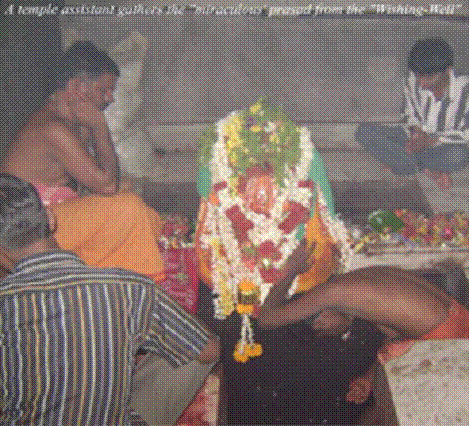 |
Recently
I got a chance to visit this temple. I was in Chitradurga as part of
my official duty. As I have a passion for traveling, I make use of the
evenings and holidays during my official tours to visit nearby tourist
locations and historically important places. When I asked Pradeep, my
colleague in our Chitradurga office, about the places of interest in
and around the town, he first listed a series of well-trodden tourist
locations such as Chitradurga fort (a magnificent structure indeed),
Chandravalli caves, Jogimati Hill Station, etc. In addition, he also
happened to mention, perhaps knowing my special interest in things called
“miracles”, this temple at Hosadurga and its miraculous wishing-well.
It was he who first told me about the television documentary. He also
offered to take us (myself and Ravishankar, my colleague from Bangalore)
to the temple. Seeing a golden chance to see a “miracle” in person,
we grabbed the opportunity.
On 16
December 2007, a Saturday, we left Chitradurga in the early hours. Hosadurga,
a small panchayat town, is only a three hour journey (by car) from here.
When we reached Hosadurga, Balraj, our colleague,was waiting for us.
Being a resident of Hosadurga and a very good host, he was to take us
to the temple. After having a delicious breakfast at his house, we left
the town.
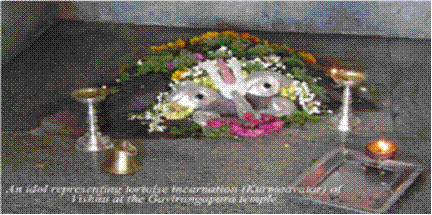 |
|
Since
all the three of my colleagues are persons with a religious bend of
mind, they decided to visit first yet another prominent temple in the
nearby village called Gavirangapura. The temple’s presiding deity
is a tortoise (Kurma avatar of Maha Vishnu). This is one of the only two temples
(in the whole of India) where the tortoise incarnation of Vishnu is
worshipped, the other one being located somewhere in Andhra Pradesh. Here,
in this temple, a garish wall-painting done possibly by a local artist,
attracted my attention. The painting is of a goddess and she is depicted
with the body of a cow and the head of a woman. |
But in his
enthusiasm to be a little realistic, the artist painted the woman with her
breasts, forgetting in the meanwhile that the body of the cow was already shown
with its udders - the beast now effectively has three mammary glands!
|
We
are side-tracking; it is now time for us to get back to our main topic
Halurameshwara and its Wishing-well. We left Gavirangapura at about
1.45 pm. We finished our lunch at a road-side restaurant (dhaba) at
Hosadurga. When we reached Halurameshwara, it was about 4 0' clock in
the evening. We could see a number of vehicles parked outside the temple
compound. This temple attracts devotees from various parts of Karnataka,
including Bangalore, if one goes by the number plates of the devotees’
vehicles. “Miracle” indeed is a flourishing business here.
The temple
has two structures - the main and the bigger one at the entrance of
the temple compound and the smaller one at the back. The wishing-well
is inside the smaller structure. Except for two aged women and a temple
priest, there was nobody in the main temple at the time of our visit.
The centre of attraction undoubtedly was the wishing-well around which
we could see a crowd of men and women - young and old - assembled. Everybody
was waiting for their turn to witness and be part of the miracle. |
|
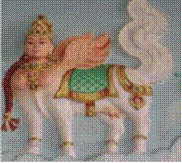 |
To witness
the miracle, one has to buy a coupon from the office and hand it over
to the gatekeeper of the well. The coupons were numbered and the devotees
would be called in serial order (unless, of course, you are a VIP) to
offer the puja. Balraj bought a coupon for us and we waited for our
turn. Since the crowd was reasonably big (though not a huge crowd),
I decided to take a walk around the temple as it would take a minimum
of one hour for our turn to come.
The well/pond
inside the temple is connected to a tank outside. The water coming out
of the temple was off-white in colour because of the offerings made
to the idol. As part of the puja/offering, the priest breaks the coconuts
brought by the devotees and the coconut milk is poured into the well.
Pieces of coconut and bananas are also dropped in the well I could also
notice a woman washing some dirty linen on the steps of the tank outside.
As a result of all these, the water inside the tank also is off-white
in colour. This whitish tinge of the water in this tank could possibly
be the reason why the temple itself is called halu-rameshwara (Halu,
in Kannada, is milk). After taking a walk around, I got back to the
entrance of the temple. By now the crowd had become thinner and I could
position myself (after a bit of jostling, of course) next to the door
which would give me a reasonably good view of the happenings inside.
Apart
from the light from the oil-lamps and the dim sun light seeping in through
the door (the temple does not have any windows), there was no light
inside. Because of this, the visibility inside the temple was poor.
I could notice electric bulbs inside the temple, but they were either
switched off or there was no current. The well (it is more like a small
pond) is rectangular in shape. The source of water here is possibly
a natural spring inside the well. A two to two and a half feet wide
marble stone pavement is done on all four sides of the well. And the
walls of the temple are built so close to the pavement that there is
not enough space to move around the well freely. Nor is one permitted
to do so. One has to climb down a few steps to reach the water level
in the well. An idol is kept on a stone beam laid across the well. Flowers,
bananas, betel leaves etc are also piled up on the beam next to the
idol. A priest was sitting on the stone paving on the left. A man in
his early twenties was standing in the water on the right.
|
At present
a new coupon number is being called and the owner of the coupon shoves
his way to the temple. He hands over a coconut, a few ripe bananas and
a bunch of flowers to the priest, who keeps the bananas and the flowers
on the pavement on his left and then breaks the coconut smashing it
on the pavement. Coconut milk and pieces of coconut fall into the well.
The devotee is asked to perform a puja to the idol. He is then asked
to sit on the pavement at the rear-right comer of the pond and pray
for his wishes to be fulfilled. (In the meantime a new number is being
called and the exercise is repeated). I was expecting that the article
would pop up on its own from inside. I could observe nothing of those
sorts. (Ravishimkar, however, told me later that he did notice a single instance
of a piece of banana popping up even when the water was left undisturbed for
some time). |
|
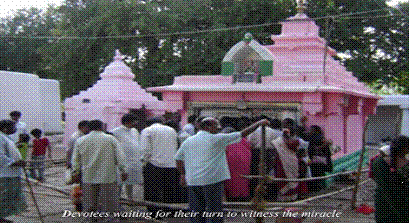 |
Instead, the
man standing in the pond stirs the water violently with his hand, searches for
something, then picks up a tom betel leaf and a piece of crushed banana from
somewhere in the pond and hands them over to the devotee. He also does not fail
to interpret the “meaning” of the miraculous gift - it is an indication that
all the wishes of the devotee would be fulfilled in the near future!
This exercise
was repeated with a few more devotees, each one getting betel leaves,
flowers, or pieces of crushed (rotten) banana. None of them got a cradle
or any other items which would unambiguously symbolize their wishes
without the need of an interpreter. Perhaps, one needs to be part of
a royal family for the divinity to come out with an unequivocal message!
The entire drama was so irksome that I lost interest, yet I decided
to wait for our turn to come.
|
We decided
that Balraj would be offering the puja and I would be accepting the
miraculous prasad. Our coupon number was called out, Balraj did the
puja with all the required devotion, and I went to the rear side of
the well to accept the prasad. But it seems we made a mistake. The gatekeeper
boy announced that we would not be given the gift, as the
denomination of the coupon we had bought was not sufficient
for the gift to pop up! It was enough only to perform a mere puja. Unaware
of the hike in tariff, Balraj had bought a coupon of lower denomination!
I was getting a bit disappointed as I was about to lose a golden chance
to observe the drama from close quarters. But Balraj, an accomplished
marketing professional and a local heavyweight, was not the one to give
up so easily. He asked me to wait and demanded the man, the prasad-picker:
“Hey, look, we are local persons, get the prasad!” Realizing the
futility of arguing with Balraj, he bends, stirs the water and,lo, picks
up a fully peeled and crushed banana! Persistence pays! While handing
over the banana, he told me to take that home and perform a puja to
fulfill my wishes! This divine interpreter did not have a clue that
my wish had just been fulfilled - a pseudo-miracle” had just a moment
ago got exposed! |
|
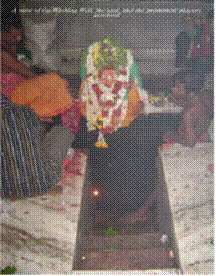 |
Where is
the “miracle”?
Try as
I may, I could not see any miracle in the whole drama enacted in the
temple. What I could see was a bunch of con-men swindling the unsuspecting
(in fact, extremely credulous) devotees, who refused to use even an
iota of their brain cells. Had these devotees asked themselves a few
simple questions, they would not have fallen prey to these day-light
robbers and wasted their time and money. Given the above narrative,
any rational person would have asked:
1. Why
did the omnipotent and omnipresent god decide to manifest himself/herself/itself
through a miracle specifically at this place and nowhere else?
2. How
authentic is the information related to the visit of the Mysore Maharani
to this temple? Is it a mere urban legend?
3. If
one assumes that this information related to the Maharani’s visit
is correct, one should ask: What made the temple deity to bring forth
a miniature cradle in response to a Maharani’s wishes, whereas the
lay persons have to satisfy with flowers, betel leaves and rotten bananas?
Why does the god have a preference for the Maharani over laypersons?
Would it not have been a better and convenient (for the Maharani at
least) miracle, had a baby itself popped up from the well!?
4. Why
does the temple assistant who picks up the prasad from the well frequently
stir up the water? Why does he not leave it alone?
5. Why
did the god decide to bring up a banana for me, an unbeliever, after
my friend Balraj demanded (almost threatened) to have one?
How to
investigate this miracle scientifically?
To have
a proper investigation of this “miracle” the cooperation of the
temple authorities is a must, which is impossible to come by. Assuming
that permission is granted, how should one go ahead?
|
1. Clean
up the well and its surrounding thoroughly.
2. Find
out the source of the water.
3. Do
not allow the temple authorities from coming near the well when a devotee
performs the puja.
4. Do
not allow the devotees to drop anything inside the well as part of their
puja.
5. Allow
the prasad to pop up on its own without any kind of interventions from
the temple authorities, devotees, or anybody else.
|
|
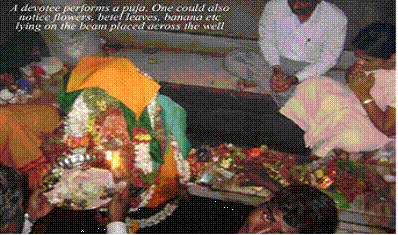 |
After
these precautions are taken, if a banana or a betel leaf still pops
up, one can reasonably assume that a miracle does occur.
A rational
explanation of the “miracle”
In the
absence of an investigation as detailed above, the only rational explanation
possible is this: the. temple authorities are conning the devotees!
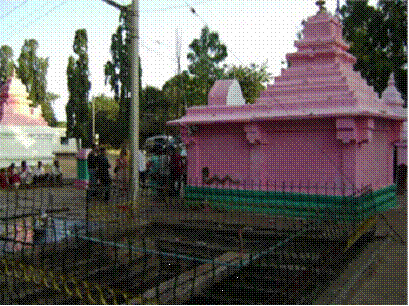 |
|
1. The
temple authorities can dump whatever they want inside the well
before the devotees are given access to it.
2. It
is also possible for the temple priest (who sits on the right side of
the idol) to clandestinely drop bananas, betel leaves, flowers, etc
into the well at regular intervals or whenever he wants to.
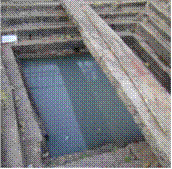 |
3. The
articles kept next to the idol on the stone beam can also be dropped
into the well unnoticed by the devotees.
4. The
devotees themselves may be dropping some articles when they conduct
the puja.
|
|
5. The
articles thus dropped inside the well may pop up under pressure from
the upward stream of the water spring inside the well.
6. The
frequent stirring of the water also helps to bring UP the articles dumped
in the well.
7. The
man, who hands over the articles to the devotees, picks up the items
not only from the reasonably visible part of the pond but even from
the dark corners of the well, including from the surface of the water
just below where the temple priest sits. This enables him to fool the
masses easily.
My experience
in this temple only reinforces my conviction that there are no miracles
in this world, only conmen and credulous believers.
Photos: B.R. Ravishankar
|
